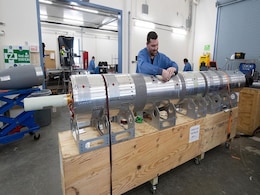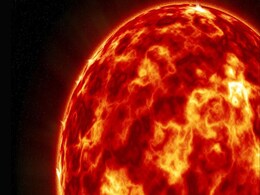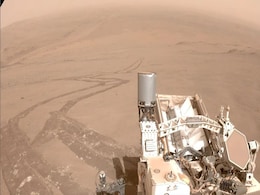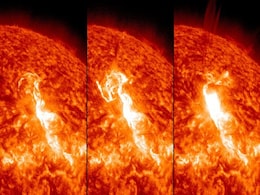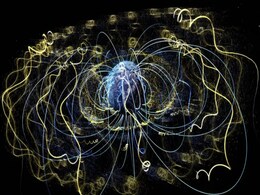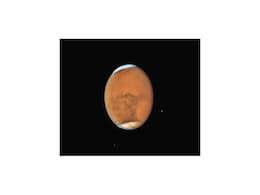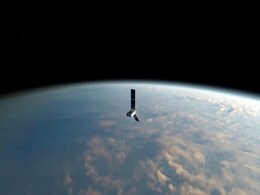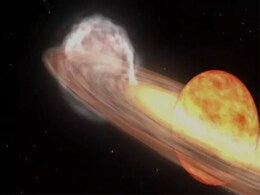Nasa Predictions
- All
- News
- Videos
-

NASA to Launch Three Rockets in Alaska to Study Auroral Substorms’ Impact
- Saturday March 29, 2025
- Written by Gadgets 360 Staff
NASA is conducting a rocket experiment from Poker Flat Research Range in Alaska. Three rockets will launch within a three-hour window to study how auroral substorms influence the Earth's upper atmosphere. Scientists will observe whether auroras drive vertical convection or if acoustic-buoyancy waves spread their energy over a wider region. Vapour t...
-
 www.gadgets360.com
www.gadgets360.com
-

NASA’s EZIE Satellites Begin Mission to Study Auroral Electrojets and Space Weather
- Friday March 21, 2025
- Written by Gadgets 360 Staff
NASA’s Electrojet Zeeman Imaging Explorer (EZIE) mission has been launched aboard a SpaceX Falcon 9 from Vandenberg Space Force Base. The trio of small satellites will map auroral electrojets, powerful currents in Earth’s atmosphere linked to solar storms. Their data will enhance space weather prediction models and help understand planetary mag...
-
 www.gadgets360.com
www.gadgets360.com
-

NASA Lowers Impact Probability of Asteroid 2024 YR4 After New Data
- Monday February 24, 2025
- Written by Gadgets 360 Staff
Asteroid 2024 YR4, initially flagged as a potential threat due to its size and energy potential, has been downgraded after refined observations. NASA now estimates just a 0.28 percent chance of impact in 2032, significantly reducing concerns. The rapid fluctuation in risk assessment was expected, as ongoing astronomical observations provide more pr...
-
 www.gadgets360.com
www.gadgets360.com
-

Partial Solar Eclipse March 2025: What You Need to Know
- Friday February 14, 2025
- Science | Edited by Nikhil Pandey
A partial solar eclipse will occur on March 29, 2025, visible from parts of the Northern Hemisphere, including Europe, Asia, Africa, North America, and South America.
-
 www.ndtv.com
www.ndtv.com
-

NASA’s PUNCH Mission Set to Track the Sun’s Corona and Solar Wind in 3D
- Friday February 7, 2025
- Written by Gadgets 360 Staff
NASA’s PUNCH mission, set for launch on Feb 27, will deploy four satellites to study the transition between the sun’s corona and the solar wind. The mission aims to improve understanding of space weather by capturing 3D images, helping predict solar storms with greater accuracy. The data will also complement NASA’s Parker Solar Probe, offerin...
-
 www.gadgets360.com
www.gadgets360.com
-

Hubble Spots Distant Supernova in Gemini, Enhancing Cosmic Distance Studies
- Tuesday February 4, 2025
- Written by Gadgets 360 Staff
The NASA/ESA Hubble Space Telescope has captured a stunning image of SN 2022aajn, a Type Ia supernova in the constellation Gemini. Located 600 million light-years away, the explosion was first detected in November 2022. Type Ia supernovae serve as essential cosmic distance markers due to their predictable brightness. Hubble’s observations, part o...
-
 www.gadgets360.com
www.gadgets360.com
-

New Research Suggests Mars Experienced Warm and Cold Periods Affecting Liquid Water
- Tuesday February 4, 2025
- Written by Gadgets 360 Staff
New research from Harvard University suggests that Mars experienced alternating warm and cold periods billions of years ago, affecting its climate and ability to sustain liquid water. These fluctuations, which lasted up to 100,000 years, may have influenced the planet’s potential for life. The study highlights the role of hydrogen in trapping hea...
-
 www.gadgets360.com
www.gadgets360.com
-

Study Finds Coronal Loop Flickers Could Predict Solar Flares Hours in Advance
- Friday January 17, 2025
- Written by Gadgets 360 Staff
NASA's Solar Dynamics Observatory has revealed a potential breakthrough in predicting solar flares. Scientists observed brightness fluctuations in coronal loops—plasma structures in the Sun's atmosphere—that intensify hours before solar flares occur. This discovery, with a prediction accuracy of 60–80%, may provide 2–6 hours of advance warn...
-
 www.gadgets360.com
www.gadgets360.com
-

AI Enhances Northern Lights Classification and Geomagnetic Storm Forecasting
- Friday January 10, 2025
- Written by Gadgets 360 Staff
A breakthrough in auroral research, powered by artificial intelligence, has allowed scientists to classify over 700 million auroral images. This effort, using NASA's THEMIS dataset, will significantly enhance the prediction of geomagnetic storms, which can disrupt Earth's communication and security systems. Led by the University of New Hampshire, t...
-
 www.gadgets360.com
www.gadgets360.com
-

NASA's LEXI Mission Will Explore Earth’s Magnetic Shield from the Moon
- Monday January 13, 2025
- Written by Gadgets 360 Staff
NASA is preparing for the launch of the Lunar Environment Heliospheric X-ray Imager (LEXI) aboard Firefly Aerospace's Blue Ghost lander, scheduled for January 15. The mission will observe Earth’s magnetosphere, capturing X-ray images that reveal how the planet's magnetic shield reacts to solar wind. This project could improve predictions of geoma...
-
 www.gadgets360.com
www.gadgets360.com
-

Mars Dust Storms May Be Predictable Based on Surface Heating Patterns
- Thursday December 12, 2024
- Written by Gadgets 360 Staff
A new study suggests warm days on Mars often precede dust storms, with researchers analysing data from NASA's Mars Reconnaissance Orbiter. The findings show 78% of storms correlate with increased solar heating, particularly in northern regions of the planet. Scientists have developed an algorithm predicting certain storm types with 64% confidence, ...
-
 www.gadgets360.com
www.gadgets360.com
-

NASA's Twin Mini Satellites Captures Far-Infrared Radiation from Polar Regions
- Thursday December 5, 2024
- Written by Gadgets 360 Staff
NASA’s PREFIRE mission, launched in 2024, is utilizing CubeSats to capture groundbreaking data on far-infrared radiation emitted from polar regions. These measurements, which track heat escaping from the Arctic and Antarctic, provide critical insights into Earth’s energy balance, a key component in understanding climate change. Despite encounte...
-
 www.gadgets360.com
www.gadgets360.com
-

Asteroid Detected Hours Before Earth Impact, Creates Fireball Over Siberia
- Wednesday December 4, 2024
- Written by Gadgets 360 Staff
On December 3, 2024, a small asteroid, C0WEPC5, measuring about 27 inches in diameter, was detected just hours before entering Earth's atmosphere. The asteroid disintegrated harmlessly over Siberia, creating a bright fireball. This marked the fourth "imminent impactor" event of the year, with three others recorded over Berlin, Hawaii, and the Phili...
-
 www.gadgets360.com
www.gadgets360.com
-

T Coronae Borealis' Nova Outburst May Happen Soon, Experts Suggest
- Tuesday December 3, 2024
- Written by Gadgets 360 Staff
Astronomers are closely monitoring T Coronae Borealis, a binary star system in the Corona Borealis constellation, for its next nova eruption. The event, expected within months, could light up the night sky as the white dwarf gathers material from its red giant companion, triggering a nuclear explosion. Advanced telescopes like NASA’s Fermi are ga...
-
 www.gadgets360.com
www.gadgets360.com
-

NASA Disasters Programme Uses Artificial Intelligence to Help Aid Response Efforts
- Wednesday November 27, 2024
- Written by Gadgets 360 Staff
NASA is leveraging artificial intelligence and open science to enhance disaster preparedness, response, and recovery efforts. During events like Hurricane Ida, NASA provided actionable data on soil moisture, flood detection, and power outages through its Disasters Mapping Portal. AI-driven tools, like blue tarp detection for damaged roofs, are aidi...
-
 www.gadgets360.com
www.gadgets360.com
-

NASA to Launch Three Rockets in Alaska to Study Auroral Substorms’ Impact
- Saturday March 29, 2025
- Written by Gadgets 360 Staff
NASA is conducting a rocket experiment from Poker Flat Research Range in Alaska. Three rockets will launch within a three-hour window to study how auroral substorms influence the Earth's upper atmosphere. Scientists will observe whether auroras drive vertical convection or if acoustic-buoyancy waves spread their energy over a wider region. Vapour t...
-
 www.gadgets360.com
www.gadgets360.com
-

NASA’s EZIE Satellites Begin Mission to Study Auroral Electrojets and Space Weather
- Friday March 21, 2025
- Written by Gadgets 360 Staff
NASA’s Electrojet Zeeman Imaging Explorer (EZIE) mission has been launched aboard a SpaceX Falcon 9 from Vandenberg Space Force Base. The trio of small satellites will map auroral electrojets, powerful currents in Earth’s atmosphere linked to solar storms. Their data will enhance space weather prediction models and help understand planetary mag...
-
 www.gadgets360.com
www.gadgets360.com
-

NASA Lowers Impact Probability of Asteroid 2024 YR4 After New Data
- Monday February 24, 2025
- Written by Gadgets 360 Staff
Asteroid 2024 YR4, initially flagged as a potential threat due to its size and energy potential, has been downgraded after refined observations. NASA now estimates just a 0.28 percent chance of impact in 2032, significantly reducing concerns. The rapid fluctuation in risk assessment was expected, as ongoing astronomical observations provide more pr...
-
 www.gadgets360.com
www.gadgets360.com
-

Partial Solar Eclipse March 2025: What You Need to Know
- Friday February 14, 2025
- Science | Edited by Nikhil Pandey
A partial solar eclipse will occur on March 29, 2025, visible from parts of the Northern Hemisphere, including Europe, Asia, Africa, North America, and South America.
-
 www.ndtv.com
www.ndtv.com
-

NASA’s PUNCH Mission Set to Track the Sun’s Corona and Solar Wind in 3D
- Friday February 7, 2025
- Written by Gadgets 360 Staff
NASA’s PUNCH mission, set for launch on Feb 27, will deploy four satellites to study the transition between the sun’s corona and the solar wind. The mission aims to improve understanding of space weather by capturing 3D images, helping predict solar storms with greater accuracy. The data will also complement NASA’s Parker Solar Probe, offerin...
-
 www.gadgets360.com
www.gadgets360.com
-

Hubble Spots Distant Supernova in Gemini, Enhancing Cosmic Distance Studies
- Tuesday February 4, 2025
- Written by Gadgets 360 Staff
The NASA/ESA Hubble Space Telescope has captured a stunning image of SN 2022aajn, a Type Ia supernova in the constellation Gemini. Located 600 million light-years away, the explosion was first detected in November 2022. Type Ia supernovae serve as essential cosmic distance markers due to their predictable brightness. Hubble’s observations, part o...
-
 www.gadgets360.com
www.gadgets360.com
-

New Research Suggests Mars Experienced Warm and Cold Periods Affecting Liquid Water
- Tuesday February 4, 2025
- Written by Gadgets 360 Staff
New research from Harvard University suggests that Mars experienced alternating warm and cold periods billions of years ago, affecting its climate and ability to sustain liquid water. These fluctuations, which lasted up to 100,000 years, may have influenced the planet’s potential for life. The study highlights the role of hydrogen in trapping hea...
-
 www.gadgets360.com
www.gadgets360.com
-

Study Finds Coronal Loop Flickers Could Predict Solar Flares Hours in Advance
- Friday January 17, 2025
- Written by Gadgets 360 Staff
NASA's Solar Dynamics Observatory has revealed a potential breakthrough in predicting solar flares. Scientists observed brightness fluctuations in coronal loops—plasma structures in the Sun's atmosphere—that intensify hours before solar flares occur. This discovery, with a prediction accuracy of 60–80%, may provide 2–6 hours of advance warn...
-
 www.gadgets360.com
www.gadgets360.com
-

AI Enhances Northern Lights Classification and Geomagnetic Storm Forecasting
- Friday January 10, 2025
- Written by Gadgets 360 Staff
A breakthrough in auroral research, powered by artificial intelligence, has allowed scientists to classify over 700 million auroral images. This effort, using NASA's THEMIS dataset, will significantly enhance the prediction of geomagnetic storms, which can disrupt Earth's communication and security systems. Led by the University of New Hampshire, t...
-
 www.gadgets360.com
www.gadgets360.com
-

NASA's LEXI Mission Will Explore Earth’s Magnetic Shield from the Moon
- Monday January 13, 2025
- Written by Gadgets 360 Staff
NASA is preparing for the launch of the Lunar Environment Heliospheric X-ray Imager (LEXI) aboard Firefly Aerospace's Blue Ghost lander, scheduled for January 15. The mission will observe Earth’s magnetosphere, capturing X-ray images that reveal how the planet's magnetic shield reacts to solar wind. This project could improve predictions of geoma...
-
 www.gadgets360.com
www.gadgets360.com
-

Mars Dust Storms May Be Predictable Based on Surface Heating Patterns
- Thursday December 12, 2024
- Written by Gadgets 360 Staff
A new study suggests warm days on Mars often precede dust storms, with researchers analysing data from NASA's Mars Reconnaissance Orbiter. The findings show 78% of storms correlate with increased solar heating, particularly in northern regions of the planet. Scientists have developed an algorithm predicting certain storm types with 64% confidence, ...
-
 www.gadgets360.com
www.gadgets360.com
-

NASA's Twin Mini Satellites Captures Far-Infrared Radiation from Polar Regions
- Thursday December 5, 2024
- Written by Gadgets 360 Staff
NASA’s PREFIRE mission, launched in 2024, is utilizing CubeSats to capture groundbreaking data on far-infrared radiation emitted from polar regions. These measurements, which track heat escaping from the Arctic and Antarctic, provide critical insights into Earth’s energy balance, a key component in understanding climate change. Despite encounte...
-
 www.gadgets360.com
www.gadgets360.com
-

Asteroid Detected Hours Before Earth Impact, Creates Fireball Over Siberia
- Wednesday December 4, 2024
- Written by Gadgets 360 Staff
On December 3, 2024, a small asteroid, C0WEPC5, measuring about 27 inches in diameter, was detected just hours before entering Earth's atmosphere. The asteroid disintegrated harmlessly over Siberia, creating a bright fireball. This marked the fourth "imminent impactor" event of the year, with three others recorded over Berlin, Hawaii, and the Phili...
-
 www.gadgets360.com
www.gadgets360.com
-

T Coronae Borealis' Nova Outburst May Happen Soon, Experts Suggest
- Tuesday December 3, 2024
- Written by Gadgets 360 Staff
Astronomers are closely monitoring T Coronae Borealis, a binary star system in the Corona Borealis constellation, for its next nova eruption. The event, expected within months, could light up the night sky as the white dwarf gathers material from its red giant companion, triggering a nuclear explosion. Advanced telescopes like NASA’s Fermi are ga...
-
 www.gadgets360.com
www.gadgets360.com
-

NASA Disasters Programme Uses Artificial Intelligence to Help Aid Response Efforts
- Wednesday November 27, 2024
- Written by Gadgets 360 Staff
NASA is leveraging artificial intelligence and open science to enhance disaster preparedness, response, and recovery efforts. During events like Hurricane Ida, NASA provided actionable data on soil moisture, flood detection, and power outages through its Disasters Mapping Portal. AI-driven tools, like blue tarp detection for damaged roofs, are aidi...
-
 www.gadgets360.com
www.gadgets360.com

